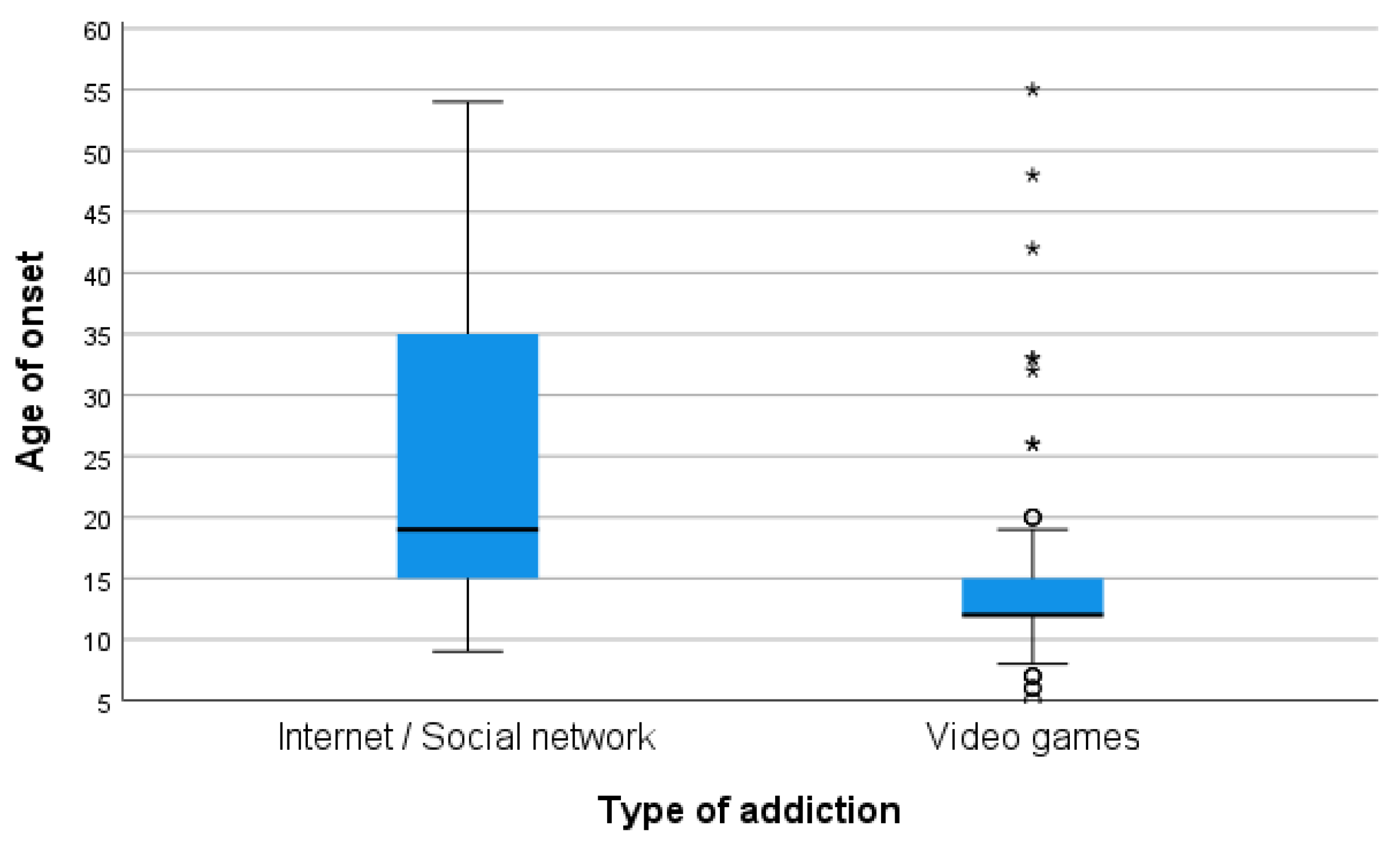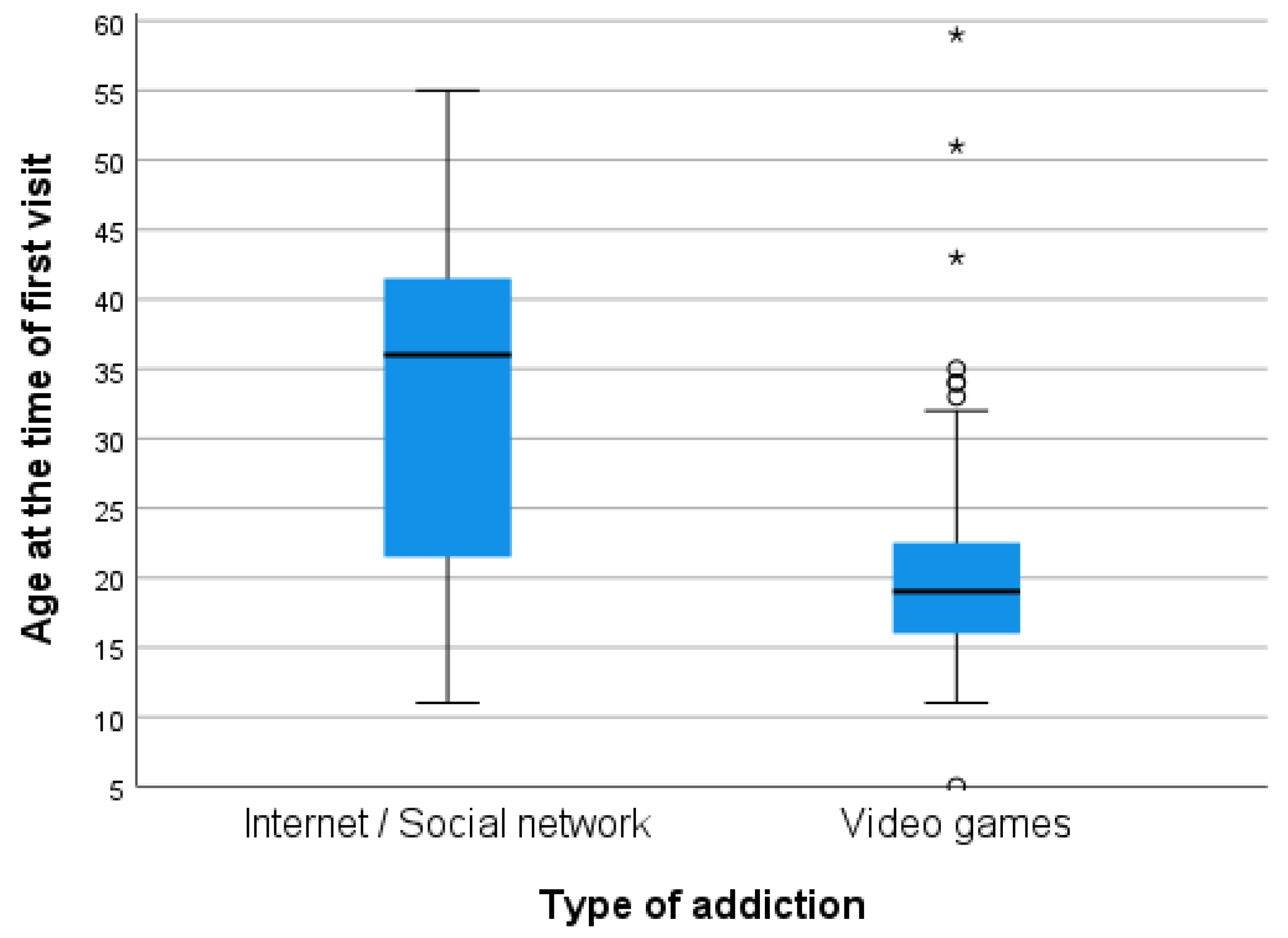Differences in Screen Addiction in the Past 15 Years
Abstract
:1. Introduction
2. Materials and Methods
2.1. Study Design
2.2. Variables and Outcomes
2.3. Statistical Analysis
3. Results
3.1. Global Sample
3.2. Temporal Evolution of the Screen Addiction Profile
3.3. Differential Clinical Characteristics of Patients According to Their Primary Screen Addiction
4. Discussion
5. Conclusions
Author Contributions
Funding
Institutional Review Board Statement
Informed Consent Statement
Data Availability Statement
Conflicts of Interest
References
- Informe ESTUDES/EDADES. 2021. Available online: https://pnsd.sanidad.gob.es/profesionales/sistemasInformacion/sistemaInformacion/pdf/ESTUDES_2021_Informe_de_Resultados.pdf (accessed on 22 July 2023).
- Kuss, D.J.; Griffiths, M.D. Social Networking Sites and Addiction: Ten Lessons Learned. Int. J. Environ. Res. Public Health 2017, 14, 311. [Google Scholar] [CrossRef]
- Alimoradi, Z.; Lotfi, A.; Lin, C.Y.; Griffiths, M.D.; Pakpour, A.H. Estimation of Behavioral Addiction Prevalence During COVID-19 Pandemic: A Systematic Review and Meta-analysis. Curr. Addict. Rep. 2022, 9, 486–517. [Google Scholar] [CrossRef]
- González-Nuevo, C.; Cuesta, M.; Muñiz, J.; Postigo, Á.; Menéndez-Aller, Á.; Kuss, D.J. Problematic Use of Social Networks during the First Lockdown: User Profiles and the Protective Effect of Resilience and Optimism. J. Clin. Med. 2022, 11, 7431. [Google Scholar] [CrossRef]
- Kuss, D.J.; Griffiths, M.D.; Karila, L.; Billieux, J. Internet addiction: A systematic review of epidemiological research for the last decade. Curr. Pharm. Des. 2014, 20, 4026–4052. [Google Scholar] [CrossRef]
- Van Rooij, A.J.; Kardefelt-Winther, D. Lost in the chaos: Flawed literature should not generate new disorders. Commentary on: Chaos and confusion in DSM-5 diagnosis of Internet Gaming Disorder: Issues, concerns, and recommendations for clarity in the field (Kuss et al.). J. Behav. Addict. 2017, 6, 128–132. [Google Scholar] [CrossRef]
- Carbonell, X.; Chamarro, A.; Oberst, U.; Rodrigo, B.; Prades, M. Problematic Use of the Internet and Smartphones in University Students: 2006–2017. Int. J. Environ. Res. Public Health 2018, 15, 475. [Google Scholar] [CrossRef]
- Pan, Y.C.; Chiu, Y.C.; Lin, Y.H. Systematic review and meta-analysis of epidemiology of internet addiction. Neurosci. Biobehav. Rev. 2020, 118, 612–622. [Google Scholar] [CrossRef]
- Stevens, M.W.; Dorstyn, D.; Delfabbro, P.H.; King, D.L. Global prevalence of gaming disorder: A systematic review and meta-analysis. Aust. N. Z. J. Psychiatry 2020, 55, 553–568. [Google Scholar] [CrossRef]
- Kim, H.S.; Son, G.; Roh, E.B.; Ahn, W.Y.; Kim, J.; Shin, S.H.; Chey, J.; Choi, K.H. Prevalence of gaming disorder: A meta-analysis. Addict. Behav. 2022, 126, 107183. [Google Scholar] [CrossRef]
- Casale, S.; Akbari, M.; Seydavi, M.; Bocci, B.S.; Fioravanti, G. Has the prevalence of problematic social media use increased over the past seven years and since the start of the COVID-19 pandemic? A meta-analysis of the studies published since the development of the Bergen social media addiction scale. Addict. Behav. 2023, 147, 107838. [Google Scholar] [CrossRef]
- Kuss, D.J.; Lopez-Fernandez, O. Internet addiction and problematic Internet use: A systematic review of clinical research. World J. Psychiatry 2016, 6, 143–176. [Google Scholar] [CrossRef]
- Kardefelt-Winther, D. Conceptualizing Internet use disorders: Addiction or coping process? Psychiatry Clin. Neurosci. 2017, 71, 459–466. [Google Scholar] [CrossRef]
- Petry, N.M.; Rehbein, F.; Gentile, D.A.; Lemmens, J.S.; Rumpf, H.J.; Mößle, T.; Bischof, G.; Tao, R.; Fung, D.S.; Borges, G.; et al. An international consensus for assessing internet gaming disorder using the new DSM-5 approach. Addiction 2014, 109, 1399–1406. [Google Scholar] [CrossRef]
- Sussman, C.J.; Harper, J.M.; Stahl, J.L.; Weigle, P. Internet and Video Game Addictions: Diagnosis, Epidemiology, and Neurobiology. Child Adolesc. Psychiatr. Clin. N. Am. 2018, 27, 307–326. [Google Scholar] [CrossRef]
- American Psychiatric Association. Diagnostic and Statistical Manual of Mental Disorders, 5th ed.; APA: Washington, DC, USA, 2013. [Google Scholar]
- Organización Mundial de la Salud (OMS). Clasificación Internacional de Enfermedades, Undécima Revisión (CIE-11); 2019–2021. Available online: https://icd.who.int/browse11 (accessed on 17 July 2022).
- Hilbert, M. Digital technology and social change: The digital transformation of society from a historical perspective. Dialogues Clin. Neurosci. 2020, 22, 189–194. [Google Scholar] [CrossRef]
- Chen, P.; Kim, S. The impact of digital transformation on innovation performance—The mediating role of innovation factors. Heliyon 2023, 9, e13916. [Google Scholar] [CrossRef]
- Zhang, J.; Bai, H.; Lu, J.; Zheng, L. Problematic use of social media: The influence of social environmental forces and the mediating role of copresence. Heliyon 2023, 9, e12959. [Google Scholar] [CrossRef]
- Hussain, Z.; Griffiths, M.D. Problematic Social Networking Site Use and Comorbid Psychiatric Disorders: A Systematic Review of Recent Large-Scale Studies. Front. Psychiatry 2018, 9, 686. [Google Scholar] [CrossRef]
- Bozzola, E.; Spina, G.; Agostiniani, R.; Barni, S.; Russo, R.; Scarpato, E.; Di Mauro, A.; Di Stefano, A.V.; Caruso, C.; Corsello, G.; et al. The Use of Social Media in Children and Adolescents: Scoping Review on the Potential Risks. Int. J. Environ. Res. Public Health 2022, 19, 9960. [Google Scholar] [CrossRef]
- Ghali, S.; Afifi, S.; Suryadevara, V.; Habab, Y.; Hutcheson, A.; Panjiyar, B.K.; Davydov, G.G.; Nashat, H.; Nath, T.S. A Systematic Review of the Association of Internet Gaming Disorder and Excessive Social Media Use with Psychiatric Comorbidities in Children and Adolescents: Is It a Curse or a Blessing? Cureus 2023, 15, e43835. [Google Scholar] [CrossRef]
- Fischer-Grote, L.; Kothgassner, O.D.; Felnhofer, A. Risk factors for problematic smartphone use in children and adolescents: A review of existing literature. Neuropsychiatry 2019, 33, 179–190. [Google Scholar] [CrossRef] [PubMed]
- Mihara, S.; Higuchi, S. Cross-sectional and longitudinal epidemiological studies of Internet gaming disorder: A systematic review of the literature. Psychiatry Clin. Neurosci. 2017, 71, 425–444. [Google Scholar] [CrossRef] [PubMed]



| Characteristics | Total (n = 118) | Pre-ICT (n = 19) | ICT (n = 68) | COVID-19 (n = 31) | p-Value |
|---|---|---|---|---|---|
| Male gender (n, %) | 108 (91.5) | 16 (14.8) | 65 (60.2) | 27 (25) | 0.170 |
| Age at onset, mean (SD) | 17 (10) | 18 (6) | 19 (12) | 11(5) | 0.000 1 |
| Age at first visit, mean (SD) | 23 (10) | 24 (8) | 24 (12) | 20 (7) | 0.117 2 |
| Main addiction (n, %) | 0.673 | ||||
| Internet/social network | 33 (27.9) | 5 (26.3) | 13 (19.1) | 5 (16.1) | |
| Video games | 95 (80.5) | 14 (73.7) | 55 (81) | 26 (84) | |
| Cohabitation (n, %) | 0.208 | ||||
| Parents | 94 (79.7) | 14 (74) | 51 (75) | 29 (94) | |
| Partner and children | 9 (7.6) | 1 (5.3) | 8 (12) | 0 | |
| Single | 8 (6.8) | 3 (16) | 3 (4.4) | 2 (6.5) | |
| Partner | 6 (5.1) | 1 (5.3) | 5 (7.4) | 0 | |
| Employment status (n, %) | 0.074 | ||||
| Working | 19 (16.1) | 4 (21) | 9 (13.2) | 6 (19.3) | |
| Studying | 71 (60.2) | 7 (36.8) | 42 (62) | 22 (71) | |
| Neither | 28 (23.7) | 8 (42.1) | 17 (25) | 3 (9.7) | |
| Time out of control (n, %) | 0.427 | ||||
| <1 year | 30 (25.4) | 3 (15.8) | 17 (25) | 10 (32.2) | |
| >1 year | 88 (74.6) | 16 (84.2) | 51 (75) | 21 (67.7) | |
| Frequency (n, %) | 0.019 | ||||
| Daily | 113 (95.8) | 16 (84.2) | 66 (97.1) | 31 (100) | |
| Weekly | 5 (4.2) | 3 (15.7) | 2 (2.9) | 0 | |
| Previous attempts to quit (n, %) | 0.220 | ||||
| Yes | 21 (17.8) | 1 (5.3) | 16 (24) | 4 (13) | |
| No | 88 (74.6) | 14 (73.7) | 50 (74) | 24 (77.4) |
| Characteristics | Total (n = 118) | Internet/Social Network (n = 23) | Video Games (n = 95) | p-Value |
|---|---|---|---|---|
| Male gender (n, %) | 108 (91.5) | 19 (17.6) | 89 (82.4) | 0.103 |
| Age at onset, mean (SD) | 17 (10) | 26 (14) | 15 (8) | 0.000 1 |
| Age at first visit, mean (SD) | 23 (10) | 31 (13) | 20 (8) | 0.000 2 |
| Treatment period (n, %) | 0.673 | |||
| Pre-ICT | 19 (16.1) | 5 (21.7) | 14 (14.7) | |
| ICT | 68 (57.6) | 13 (56.5) | 55 (57.9) | |
| COVID-19 | 31 (26.3) | 5 (21.7) | 26 (24.4) | |
| Cohabitation (n, %) | 0.000 | |||
| Parents | 94 (79.7) | 10 (43.5) | 84 (93.7) | |
| Partner and children | 9 (7.6) | 5 (21.7) | 4 (4.2) | |
| Single | 8 (6.8) | 4 (17.4) | 4 (4.2) | |
| Partner | 6 (5.1) | 4 (17.4) | 2 (2.1) | |
| Employment status (n, %) | 0.000 | |||
| Working | 19 (16.1) | 12 (52.2) | 7 (7.4) | |
| Studying | 71 (60.2) | 6 (26.1) | 65 (68.4) | |
| Neither | 28 (23.7) | 5 (27.3) | 23 (24.2) | |
| Time out of control (n, %) | 0.289 | |||
| <1 year | 30 (25.4) | 8 (34.8) | 22 (23.2) | |
| >1 year | 88 (74.6) | 15 (65.2) | 73 (76.8) | |
| Frequency (n, %) | 0.582 | |||
| Daily | 113 (95.8) | 23 (100) | 90 (94.7) | |
| Weekly | 5 (4.2) | 0 | 5 (5.3) | |
| Previous attempts to quit (n, %) | 0.769 | |||
| Yes | 21 (17.8) | 5 (21.7) | 16 (16.8) | |
| No | 88 (74.6) | 18 (78.3) | 70 (73.7) | |
| Psychiatric comorbidity (n, %) | 41 (34.7) | 5 (21.7) | 36 (37.9) | 0.133 |
Disclaimer/Publisher’s Note: The statements, opinions and data contained in all publications are solely those of the individual author(s) and contributor(s) and not of MDPI and/or the editor(s). MDPI and/or the editor(s) disclaim responsibility for any injury to people or property resulting from any ideas, methods, instructions or products referred to in the content. |
© 2023 by the authors. Licensee MDPI, Basel, Switzerland. This article is an open access article distributed under the terms and conditions of the Creative Commons Attribution (CC BY) license (https://creativecommons.org/licenses/by/4.0/).
Share and Cite
Aragay, N.; Vallès, V.; Ramos-Grille, I.; Garrido, G.; Grimalt, E.G.; Miranda Ruiz, E.; Jovell-Fernández, E. Differences in Screen Addiction in the Past 15 Years. Int. J. Environ. Res. Public Health 2024, 21, 1. https://doi.org/10.3390/ijerph21010001
Aragay N, Vallès V, Ramos-Grille I, Garrido G, Grimalt EG, Miranda Ruiz E, Jovell-Fernández E. Differences in Screen Addiction in the Past 15 Years. International Journal of Environmental Research and Public Health. 2024; 21(1):1. https://doi.org/10.3390/ijerph21010001
Chicago/Turabian StyleAragay, Núria, Vicenç Vallès, Irene Ramos-Grille, Gemma Garrido, Enric Gamundi Grimalt, Elena Miranda Ruiz, and Esther Jovell-Fernández. 2024. "Differences in Screen Addiction in the Past 15 Years" International Journal of Environmental Research and Public Health 21, no. 1: 1. https://doi.org/10.3390/ijerph21010001
APA StyleAragay, N., Vallès, V., Ramos-Grille, I., Garrido, G., Grimalt, E. G., Miranda Ruiz, E., & Jovell-Fernández, E. (2024). Differences in Screen Addiction in the Past 15 Years. International Journal of Environmental Research and Public Health, 21(1), 1. https://doi.org/10.3390/ijerph21010001






